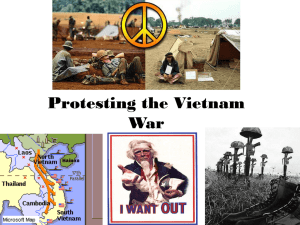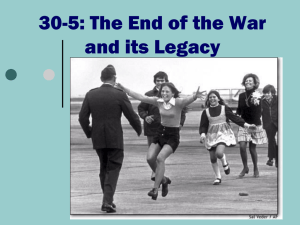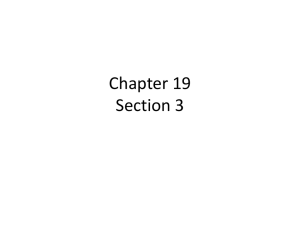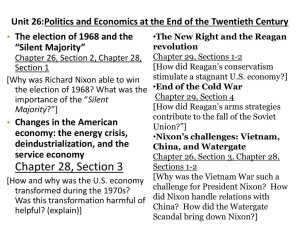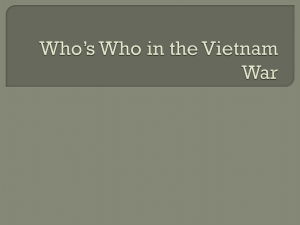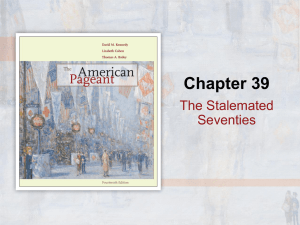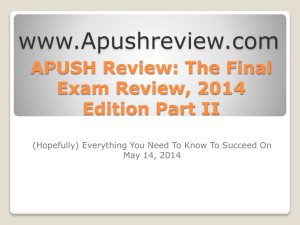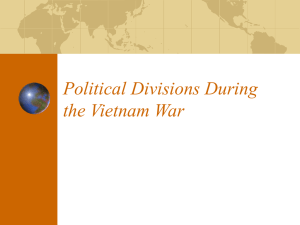The War Ends - Waverly-Shell Rock Community Schools
advertisement
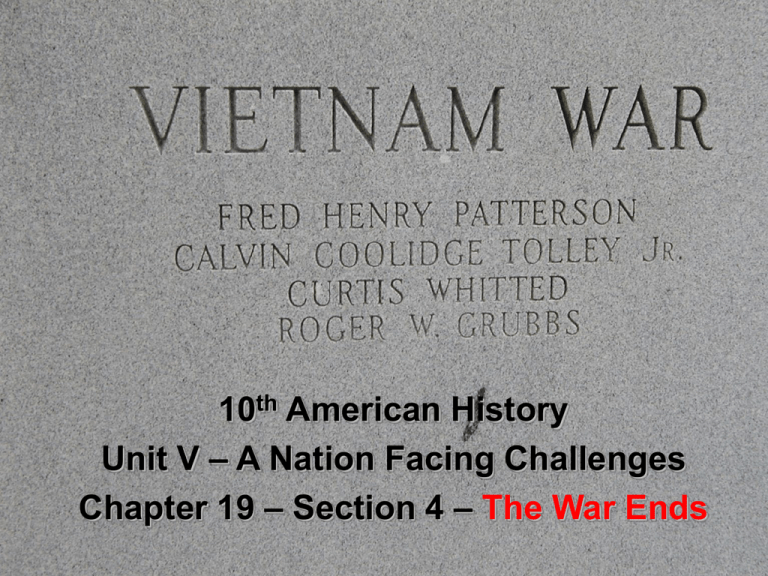
10th American History Unit V – A Nation Facing Challenges Chapter 19 – Section 4 – The War Ends The War Ends The Main Idea President Nixon eventually ended U.S. involvement in Vietnam, but the war had lasting effects on the United States and in Southeast Asia. Reading Focus • How did President Nixon’s policies widen U.S. involvement in the war? • How and why did protests against the war increase? • How did Nixon achieve an end to U.S. involvement in Vietnam? • What was the war’s legacy in the United States and in Vietnam? Why are we in Vietnam? • “Domino Theory”Eisenhower • Stop Aggression • Protect our reputation- our “credibility” Situation in Vietnam prior to Nixon’s Election in 1968- 5:12 min. How did President Nixon’s policies widen U.S. involvement in the war? • During his 1968 campaign, Nixon pledged to end the war in Vietnam. • Nixon and his National Security Advisor Henry Kissinger devised plans to end the war. • In 1969 Kissinger began secret peace negotiations in Paris with North Vietnamese revolutionary Le Duc Tho. • The U.S. strategy aimed at achieving “peace with honor.” – Vietnamization – Laos and Cambodia Vietnamization & the Anti-war Movement (03:33) Nixon and Vietnamization • The plan was to encourage the South Vietnamese to take more responsibility for fighting the war. • It was hoped that this policy would eventually enable the United States to withdraw gradually all their soldiers from Vietnam. • July 1969, the 540,000 US troops were to be reduced by 25,000. • To increase the size of the ARVN (Army of the Republic of Vietnam), a mobilization law was passed in South Vietnam that called up into the army all men between seventeen and forty-three years of age. Nixon and Vietnamization 4:30 min. "carrot and stick" strategy • Negotiate through strength • Nixon proposed "mutual withdrawal" of troops and no more bombing of North Vietnam- Jan. 25, 1969 • Nixon's advisers told him that they feared that the gradual removal of all US troops would eventually result in a National Liberation Front victory. It was therefore agreed that the only way that America could avoid a humiliating defeat was to negotiate a peace agreement in the talks that were taking place in Paris. • Madman Theory- In an effort to put pressure on North Vietnam in these talks. Bob Haldeman, one of the US chief negotiators, was told to give the impression that President Nixon was mentally unstable and that his hatred of communism was so fanatical that if the war continued for much longer he was liable to resort to nuclear weapons against North Vietnam. Phoenix Program • Another Nixon innovation- secret Vietnamese were trained by the CIA to infiltrate peasant communities and discover the names of NLF sympathizers. • When they had been identified, Death Squads were sent in to execute them. • Between 1968 and 1971, an estimated 40,974 members of of the NLF were killed in this way. • It was hoped that the Phoenix Program would result in the destruction of the NLF organization, but, as on previous occasions, the NLF was able to replace its losses by recruiting from the local population and by arranging for volunteers to be sent from North Vietnam. Nixon’s Secret War 2:44 min . • Nixon secretly widened the war to force the North Vietnamese to negotiate. Secret bombing of North Vietnamese and Cambodian bases in Cambodia While enlarging the war Nixon also began to withdraw troops. In 1970, the communists in Cambodia overthrew the leader Prince Sihanouk and took over (Khmer Rouge). U.S. and South Vietnamese leadership were concerned with Vietcong and North Vietnamese bases located in Cambodia across the South Vietnam border (Mekong River). President Nixon gave the approval for an April, 30, 1970 attack across the border into Cambodia by the Allies and U.S. Tanks- an incursion. This seemed to be in direct conflict with administration’s attempt to scale down the war (Vietnamization) Cambodian Incursion 1969-1970 • • • • Widening the War Vietnamization • Strategy of turning over more of the fighting in Vietnam to the South Vietnamese while gradually bringing U.S. ground troops home • Nixon hoped this would give South Vietnamese leaders time to create a stable, nonCommunist government. • Nixon began to slowly withdraw U.S. forces from South Vietnam. • Antiwar activists opposed the plan calling for an immediate end to the war. • Nixon believed he had the backing of the silent majority of Americans. Laos and Cambodia • At the same time, Nixon was secretly expanding the war. • He ordered the bombing of Cambodia to disrupt the flow of supplies on the Ho Chi Minh trail. • Concealed the air strikes from the American people—including members of Congress • Sent U.S. and ARVN troops into Cambodia and into Laos to destroy North Vietnamese army bases • Renewed bombing of North Vietnam • Nixon hoped to force North Vietnam to seek peace. Ho Chi Minh Trail • The US could never stem the flow of supplies to the Ho Chi Minh Trail and this was crucial to keep the guerrilla war going. • Communist forces had been using what was then known as the Truong Son Route since at least 1959 to infiltrate men and materiel through Laos into South Vietnam. Not only was it a lifeline, it served as a basing area and a sanctuary in Laos for staging operations into South Vietnam. Vietnam 1970 • • • • • • • • North Vietnam invasion of Laos and Cambodia Feb. 21 - defeated Hmong army and captured Plain of Jarres - created Khmer Rouge Cambodia coup Mar. 18 - neutralist Sihanouk replaced by pro-U.S. Lon Nol Nixon saw film Patton Apr. 25 - made decision next day to invade Cambodia Cambodia invasion Apr. 30 - 32,000 U.S. troops attack the Fishhook and Parrot's Beak for 2 months - destroy NV supplies and set back NV plans for 2 years - a military success but political disaster Kent State demonstration May 4 against ROTC - 4 students killed Cooper-Church amendment to limit U.S. troops in Laos and Cambodia passed Senate 58-37 on June 30 Le Duc Tho and Kissinger met in Paris for 3rd round of talks in June Hatfield-McGovern amendment to require complete withdrawal from Vietnam failed in Sept. Vietnam 1971 • • • • • Winter Soldier investigation Jan. 31-Feb. 2 by John Kerry and the Vietnam Veterans against the War - 116 vets testified about atrocities committed by U.S. in Vietnam. Operation- Lam Son 719 - ARVN invade Laos Feb. 8 with U.S. air support - but failed to close the Ho Chi Minh trail and showed that Vietnamization had failed. Kissinger met with Le Duc Tho is secret talks in house on the Rue Darthe in Feb. rather than the formal talks at the Hotel Majestic, but stalled. Ping-pong team visit to China Apr. 10 Nixon ended of 21-year trade embargo in June. New York Times published Pentagon Papers June 13. • Vietnam 1972 • • • • • • • • Nixon arrived in China Feb. 21 - Shanghai Communique North Vietna invasion of Quang Tri Mar. 30 Nixon responded with Op. Linebacker Apr. 6 bombing north of DMZ - B-52 raids on Hanoi and Haiphong Apr. - 1,300 air strike sorties, May 1 - low point for Nixon's "Vietnamization" policy - collapse of SV seemed inevitable Le Duc Tho and Kissinger met in Paris May 2 - 4th round of talks fail - talks suspended May 4 Nixon decided May 8 to mine Haiphong harbor and blockade NV coast - 4 aircraft carriers added to 7th Fleet - massive bombing and "jugular diplomacy" successful Nixon arrived in Moscow May 22 - SALT I treaty signed May 29 - Brezhnev agreed to help pressure NV Le Duc Tho and Kissinger met in Paris July-Aug. 5th round of talks finally made progress - NV agreed to coalition government and Kissinger agreed to allow NV Kissinger TV press conference Oct. 26 - "peace is at hand” Nixon ultimatum to North Vietnam Dec. 14 to resume negotiations or "suffer the consequences" Vietnam 1973 • Kissinger and Le Duc Tho signed treaty Jan. 27 in Paris – POWs released in 60 days, return began of 591 U.S. POWs – ceasefire under International Commission of Control and Supervision (ICC), – coalition government in SV to arrange elections, U.S. aid to SV to continue • • • U.S. troops withdrawn by March, yet bombing continued. Congress cut off funds for war June 30, to become effective Aug. 15 War Powers Act passed Nov. 7 over Nixon's veto One Week's Dead (01:39) Widening the War • How did President Nixon’s policies widen U.S. involvement in the war? • Recall – What was Vietnamization? • Analyze – Why do you think Nixon kept his expansion of the war secret? • Evaluate – How well did Nixon’s “Madman Theory” work? War Protests • In 1970 Nixon announced that he had ordered troops into Cambodia. • Antiwar protests intensified—especially on college campuses. • Antiwar protests erupted into violence. • Nixon believed that antiwar protesters represented only a minority of Americans. • Radical antiwar groups turned to violent measures to oppose the war. • More and more Americans began to oppose the war when they learned about the My Lai massacre and the Pentagon Papers. Increasing Protests Campus Violence • Kent State University in Ohio • 4 students were killed and 9 injured • Jackson State College in Mississippi • 2 students were killed and 9 wounded Antiwar Movement • Polls showed that fifty percent of Americans opposed the war. • Coalition of clergy, trade unionists, and veterans established a nationwide day of protest called Moratorium Day. • 250,000 protesters made up the largest antiwar demonstration in U.S. history. Radical Protests • Some antiwar groups turned to violent measures. • The Weathermen set off more than 5,000 bombs and carried out the Days of Rage. • Most antiwar protesters did not support extremist groups or terrorist measures. Anti-War Protests 1969 • • • • In the United States the Cambodian incursion sparked renewed Anti-War reactions. Demonstrations got louder and stronger. Nixon appeals to the “Silent Majority” for support of the war. June 1969- “Sense of the Senate” barred military operations in any country without Congressional approval. June 24, 1970- Senate repealed the Tonkin Gulf Resolution. Kent State May 4, 1970 Protests against the Cambodian Incursion at Kent State University in Ohio caused the Governor to call out the National Guard. A frightened guard unit opened fire at the unarmed protestors killing 4. More that 80 colleges and universities suspended classes. Mary Ann Vecchio (01:07) The Pentagon Papers (03:46) Rebellion and the Weathermen • The Weathermen, also known as the Weather Underground Organization, • "revolutionary organization of communist men and women" splintered from the Students for a Democratic Society (SDS). • Weathermen advocated the overthrow of the government of the United States and the system of capitalism; toward that end, they carried out a campaign of bombings, jailbreaks, and riots. • In October 1969, the Weathermen organized their first event, called the "Days of Rage," in Chicago • n 1970, the group issued a Declaration of War against the United States government, changing its name to the "weather underground organization", adopting fake identities, and pursuing covert activities only. Broke Timothy Leary out of Jail. Increasing Protests My Lai Massacre Pentagon Papers • Troops under Lieutenant William Calley killed at least 450 men, women, and children in the village of My Lai while on a search-anddestroy mission. • A collection of secret government documents that traced the history of U.S. military involvement in Vietnam since the Truman years • No Vietcong were found in the village. • Revealed that government officials had been misleading the American people about the war for years • The My Lai massacre was kept quiet at first, but former soldiers began talking about it. • This atrocity intensified the divisions between war supporters and opponents. • Calley was convicted of murder and sentenced to life in prison; he was paroled in 1974. • Daniel Ellsberg leaked the papers to the press. • Ellsberg originally supported the war, but then concluded that few South Vietnamese civilians supported the U.S.backed government. Continuing War (04:22) My Lai Massacre - March 16, 1968 My Lai Massacre - March 16, 1968 • • • • • • • American soldiers under the command of Lt. Calley entered the village of My Lai on a Search and Seizure mission. By the end of the day the soldiers had slaughter between 175-400 men, women and children of the village. Lt. Calley called the victims- non humans, an enemy with whom one could not speak or reason. Lt. Calley had no remorse, and said simply that he was following orders- the “mere gook rule”, which meant he could be a self appointed Judge, jury and executioner. Due to some large losses in Charlie Company, Calley had said the Capt. had given orders to treat all native as the enemy and destroy everyone and everything in My Lai. Often prisoners in such cases were used as guides over trails that could be booby trapped or to walk first through mine fields. If they were too slow they were shot. The orders of the day were common- burn the houses, kill the animals, destroy food and wells and round up the people. Lt. Calley was found guilty and served 1/3 of the sentence, and received a dishonorable discharge. Increasing the Protests • Recall – What happened at Kent State? • Summarize – Why did students and faculty at a number of universities go on strike? • Develop – Do you think President Nixon’s comment about not letting the minority dictate his actions in Vietnam was valid? Explain your answer. Increasing the Protests • Recall – Who were the weathermen? • Summarize – What was the My Lai Massacre? • Evaluate – How do you think the My Lai massacre and the Pentagon Papers influenced American opinion about the war? U.S. Involvement in Vietnam Ends George McGovern • Senator from South Dakota who criticized war • Insisted that the Vietnam War be brought to an immediate end • Lowered the voting age from 21 to 18 26th • Amendment 1972 Election McGovern hoped the ratification of this amendment would boost his election chances. • Nixon stressed law and order at home and told voters he would end the war. • Kissinger announced a breakthrough in the peace talks just weeks before the election. • The announcement helped Nixon win by a landslide. A Peace Agreement Nixon tried to force North Vietnam to make peace concessions by ordering the so-called Christmas bombing. It failed to work. Officials from North Vietnam, South Vietnam, and the United States finally reached an agreement in January 1973. The United States agreed to withdraw all of its troops and help rebuild Vietnam. Both sides agreed to release all prisoners of war. The agreement did not settle the political future of South Vietnam—the key issue behind the war from the start. End of U.S. Involvement • How did Nixon achieve an end to U.S. involvement in Vietnam? • Recall – What was the twenty-sixith Amendment? • Analyze – What was the effect of Kissinger’s comment that peace with Vietnam was at hand? • Evaluate – What did the “Christmas bombing” accomplish? The Vietnam War’s Legacy • Two years after U.S. troops were withdrawn, North Vietnamese troops invaded South Vietnam. • After a short amount of fighting, South Vietnam surrendered. – The U.S. military rushed to evacuate Americans still working in Saigon. – Some 130,000 South Vietnamese were also evacuated and flown to the United States. • After two decades of “temporary” division, Vietnam was reunited under a Communist government. • In 1975, Communist forces called the Khmer Rouge gained control of Cambodia. – Vietnam forces invaded Cambodia in 1979, overthrew the Khmer Rouge, and occupied the country till 1989. Fall of Vietnam and Indochina- 1975 • Vietnam – • Cambodia – • Fall of Saigon Apr. 29, 1975- Ambassador Graham Martin and 7100 U.S. and SV personnel evacuated Apr. 30, 1975 Khmer Rouge – Pol Pot Laos – Pathet Lao Victory of North Vietnam 1975 • Collapse of ARVN and South Vietnamese Government- The South Vietnamese Army withdrew from the Central Highland, leaving Saigon open to invasion from the North Vietnamese. The United States refused to provide additional aid • April 21, the South Vietnamese president resigned and fled • Fall of Siagon- On April 30, 1975, Saigon fell to North Vietnamese tanks. • The End-On April 30, just as the last U.S. helicopter was lifting off, the North Vietnamese Army swept into Saigon Cambodia and Khmer Rouge Pol Pot • The Khmer Rouge, led by Pol Pot, killed close to 1.7 million people in the mid- to late 1970s. • Money, private property, education and religion were abolished and Cambodia's towns and cities were emptied as the population was forced into massive, unworkable agricultural collectives. • In addition to death from work starvation and exhaustion, the regime killed anyone suspected with connections with either the defeated Khmer Republic government or the previous Sihanouk government, as well as intellectuals (Pol Pot defined anyone who wore glasses as automatically an intellectual), professionals, and also ethnic Vietnamese, Chinese, Chams, Laotians, and Thai. Killing Fields • Killing Fields- 1975 – cities emptied or people sent to the countryside. Phnom Penh – new rules- religion, money and private ownership were all banned; communications with the outside world elimated; family relationships dismantled. All previous rights and responsibilities were thrown out the window. – New People with education, doctor, teacher, lawyers, etc. were killed. They chose to live in cities and were easy to identify. – The CIA estimated that between 50,000 and 100,000 people were executed by the Khmer Rouge, but executions represented only a minority of the death toll, which mostly came from starvation. • Boat People- refuges. • Dec. 28, 1978- Vietnamese invasion of CambodiaLiberators or Invaders? The end of the Khmer Rouge Killing Fields 2:41 min. End of Laos 1975 • Years of bitter revolutionary struggle, ending with Americas secret war between 1964 and 1973, left Laos the most bombed country in the history of warfare. • Fall of Laos- In 1975 the communist Pathet Lao took control of the government. Pathet Lao was a communist, nationalist political movement and organization in Laos. • Hmong rebels CIA secret army- left behind The Legacy of the Pol Pot Regime and Khmer Rouge (01:46) The Legacy of the War Southeast Asia Veterans Political Impact • 635,000 South Vietnamese died; Vietcong and NVA war dead equaled 1 million • 58,000 Americans were killed; 600 were held as POWs; 2,500 soldiers reported MIA; 300,000 wounded • United States failed to prevent Communists from taking over South Vietnam. • Severe environmental damage from bombs and defoliants • More than 1.5 million South Vietnamese fled the country after the fall of Saigon. • Experienced a negative reception upon return • Trouble readjusting to civilian life (posttraumatic stress disorder) • Spent more than $150 billion on the war • Changed how many Americans viewed government • Congress passed the War Powers Act in 1973. War Powers Act - 1973 • To ensure that Congress and the President share in making decisions that may get the U.S. involved in hostilities. • Requires the President to consult with Congress prior to the start of any hostilities. • Under the act, the President can only send combat troops into battle or into areas where ''imminent'' hostilities are likely, for 60 days without either a declaration of war by Congress or a specific Congressional mandate. • The President can extend the time the troops are in the combat area for 30 extra days, without Congressional approval, for a total of 90 days. The Legacy of Vietnam • What was the war’s legacy in the United States and in Vietnam? • Recall – Who were the Khmer Rouge? • Analyze – How did the war change the makeup of the U.S. population? • Elaborate – Why do you think many refugees were willing to travel across the sea on tiny, overcrowded boats in order to leave Vietnam? The Legacy of Vietnam • Recall – How may U.S. soldiers died or were wounded in Vietnam? • Analyze – Why did many veterans experience ongoing problems from their service in Vietnam? • Contrast – How were Vietnam War veterans treated differently than veterans of previous wars? The Legacy of Vietnam • Recall – Who was Maya Ying Lin? • Explain – How did the War Powers Act of 1973 limit presidential authority? • Analyze – Why do you think Vietnam veterans led the effort to establish normal relations with Vietnam?
![vietnam[1].](http://s2.studylib.net/store/data/005329784_1-42b2e9fc4f7c73463c31fd4de82c4fa3-300x300.png)
